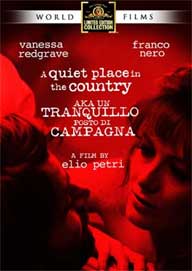 A
QUIET PLACE IN THE COUNTRY (1968)
A
QUIET PLACE IN THE COUNTRY (1968)Director: Elio Petri
MGM Limited Edition Collection
 A
QUIET PLACE IN THE COUNTRY (1968)
A
QUIET PLACE IN THE COUNTRY (1968)CAMELOT’s Vanessa Redgrave and Franco Nero seek A QUIET PLACE IN THE COUNTRY and find murder and madness, courtesy of MGM’s Limited Edition Collection MOD (made-on-demand) DVD line.
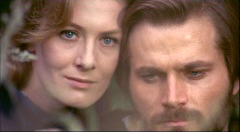
Modern artist Leonardo Ferri’s (Franco Nero, DJANGO) creative batteries are drained and he wants to get away from the city. Although his art dealer/lover Flavia (Vanessa Redgrave, BLOW-UP) finds him a spacious villa, Leonardo finds himself drawn to an older, crumbling villa. Despite her warnings that the villa is not a good investment, Flavia arranges for Leonardo to buy it and pops in and out with various supplies and modern conveniences and to make sure he is working; but Leonardo soon discovers he’s not alone. Doors slam on their own and someone or something totally demolishes his workroom. Leonardo learns from some of the villagers that a promiscuous countess named Wanda Valier (Gabriella Grimaldi, JOHNNY HAMLET) was killed at the villa 20 years before when an English fighter plane riddled the villa with bullets. When Flavia drops by to spend the night, the house seems to react violently to her presence. She nearly falls through the floor and a portion of the roof collapses on her, and then a shelf of bricks almost crushes her. Flavia jokes that the house doesn’t like her and leaves, but Leonardo wants to find out more about Wanda. He visits her ailing-yet-predatory mother (Madeleine Damien, DIARY OF A CHAMBERMAID) and pays her off for some photographs of Wanda, who becomes his new inspiration (not for painting, as he has lost the desire to create). Leonardo also questions Wanda’s former suitors, including the villa’s groundskeeper Attilio (Georges Geret, IS PARIS BURNING?). Flavia fears that another woman has taken him away from her. Leonardo gathers several of Wanda’s suitors – along with Flavia – for a séance at the villa, after which it seems as though Leonardo himself poses the greater danger to Flavia (although it is uncertain whether he has become possessed or if he is trying to please Wanda’s ghost).
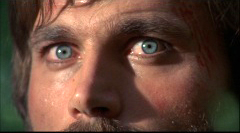 A
QUIET PLACE IN THE COUNTRY is another one of Elio Petri’s (THE TENTH VICTIM,
INVESTIGATION OF A CITIZEN ABOVE SUSPICIOUS) arty, sexy exploitation pictures,
but it is also an effectively chilling bucolic ghost story. The supernatural
attacks on Flavia are unexpected and the séance scene is genuinely chilling.
Based on the Oliver Onions novella “The Beckoning Fair One,” the
Victorian setting so ripe for a ghost story is transformed into a pop-art sixties
Italy. The gothic villa setting is invaded by Leonardo’s modern paintings,
pornographic magazines, as well as modern conveniences – supplied by Flavia
so Leonardo won’t waste time doing anything but painting – like
a dishwasher (which Leonardo uses to wash his brushes). Nero and Redgrave had
met on the set of CAMELOT the year before and she divorced Tony Richardson in
1968 (Richardson was already seeing Jeanne Moreau at the time). Although their
relationship would be rather stormy later on (Redgrave had a fifteen year relationship
with Timothy Dalton from 1971 to 1986, but married Nero in 2006), it is hard
not to read something into their onscreen relationship here, with Leonardo making
reference to Flavia’s wealthy husband and Flavia clinging desperately
to Leonardo and proclaiming that she only wants his happiness.
A
QUIET PLACE IN THE COUNTRY is another one of Elio Petri’s (THE TENTH VICTIM,
INVESTIGATION OF A CITIZEN ABOVE SUSPICIOUS) arty, sexy exploitation pictures,
but it is also an effectively chilling bucolic ghost story. The supernatural
attacks on Flavia are unexpected and the séance scene is genuinely chilling.
Based on the Oliver Onions novella “The Beckoning Fair One,” the
Victorian setting so ripe for a ghost story is transformed into a pop-art sixties
Italy. The gothic villa setting is invaded by Leonardo’s modern paintings,
pornographic magazines, as well as modern conveniences – supplied by Flavia
so Leonardo won’t waste time doing anything but painting – like
a dishwasher (which Leonardo uses to wash his brushes). Nero and Redgrave had
met on the set of CAMELOT the year before and she divorced Tony Richardson in
1968 (Richardson was already seeing Jeanne Moreau at the time). Although their
relationship would be rather stormy later on (Redgrave had a fifteen year relationship
with Timothy Dalton from 1971 to 1986, but married Nero in 2006), it is hard
not to read something into their onscreen relationship here, with Leonardo making
reference to Flavia’s wealthy husband and Flavia clinging desperately
to Leonardo and proclaiming that she only wants his happiness.

On the other hand, Redgrave and Nero may simply have embraced the characters’ sadomasochistic relationship as an acting challenge with a side of exhibitionism. As the seemingly possessed Leonardo, Nero adopts an unsetting gaze that anticipates both Jack Nicholson in THE SHINING and James Brolin in THE AMITYVILLE HORROR. Since this is an Elio Petri (THE 10TH VICTIM) film, it is in no way a straightforward ghost story. Leonardo’s creative mind is subject to hallucinations from the start, but they are not just cinematic game-playing on the part of Petri. Leonardo’s fears of failure are depicted through dreams and hallucinations of Flavia’s materialistic excess, Flavia as his nursemaid, and his murderer (“We almost had it all,” she says as she stabs him). He accuses her of only being with him for his profitability as an artist, but it seems that she is carrying him (or at least managing his money since she has to ask him to leave him some cash before she goes out to work). Several times, Leonardo hallucinates killing Flavia violently and also replaces the various men in the flashbacks of Wanda’s conquests. In its merging of the past and present – sometimes in the same shot – the film would make a good companion piece with Stephen Weeks’ period GHOST STORY (1973). The film is one of the few psychological horror films that is successful at making the audience question how much of the haunting is a projection of the unstable hero. When Redgrave says at the end “I almost envy him,” one wonders if it is not the villa but Leonardo’s final destination that is the titular “quiet place in the country.” The countess isn’t the only female to turn Leonardo’s eye, there’s also young housekeeper Egle (Rita Calderoni, later of NUDE FOR SATAN, DELIRIUM, and THE REINCARNATION OF ISABEL), who shares her garret room bed with her little brother (along with Nero in a humorous scene in which the three are spooked by ghostly doings in the night).
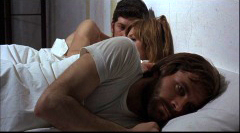 Technical
credits are top-notch with cinematography by Luigi Kuveiller (DEEP RED) –
Mario Bava’s cameraman Ubaldo Terzano operated the camera for Kuveiller,
as he would also do on DEEP RED, NEW YORK RIPPER, A LIZARD IN A WOMAN’S
SKIN, ANDY WARHOL’S DRACULA and FRANKENSTEIN, and Petri’s INVESTIGATION
OF A CITIZEN ABOVE SUSPICION) – editing by Visconti’s editor of
choice Ruggero Mastroianni (CONVERSATION PIECE), set design by Sergio Canevari
(BAY OF BLOOD), and a wonderfully giallo-esque score by Ennio Morricone –
in collaboration with the improvisational group Nuova Consonanza – pre-dating
THE BIRD WITH THE CRYSTAL PLUMAGE. Leonardo’s paintings are the work of
Neo-Dada artist Jim Dine.
Technical
credits are top-notch with cinematography by Luigi Kuveiller (DEEP RED) –
Mario Bava’s cameraman Ubaldo Terzano operated the camera for Kuveiller,
as he would also do on DEEP RED, NEW YORK RIPPER, A LIZARD IN A WOMAN’S
SKIN, ANDY WARHOL’S DRACULA and FRANKENSTEIN, and Petri’s INVESTIGATION
OF A CITIZEN ABOVE SUSPICION) – editing by Visconti’s editor of
choice Ruggero Mastroianni (CONVERSATION PIECE), set design by Sergio Canevari
(BAY OF BLOOD), and a wonderfully giallo-esque score by Ennio Morricone –
in collaboration with the improvisational group Nuova Consonanza – pre-dating
THE BIRD WITH THE CRYSTAL PLUMAGE. Leonardo’s paintings are the work of
Neo-Dada artist Jim Dine.
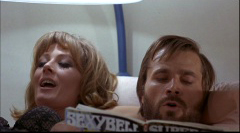 In
the States, A QUIET PLACE IN THE COUNTRY disappeared from circulation after
its theatrical release only to turn up years later officially – although
it had been available from a couple gray market labels – on MGM VHS as
part of their Amazon.com exclusive series (which also featured the first uncut
American release of Tony Maylam’s THE BURNING as well as some more bewildering
picks like the 21st Century Film Corp. pick-up DANCE MACABRE with Robert Englund
and CURSE 2: THE BITE). The film then turned up in a new 16:9 transfer from
CDE in Italy, but it was not English-friendly (although a number of fandubs
and fansubs of this edition turned up not long afterwards). More recently, the
film was remastered and premiered on an English-friendly Spanish DVD edition
through MGM (in addition to showing on U.S. cable television). Alas, MGM’s
have gone the DVDR route with this important title for its domestic release
(a barebones, dual-layer pressed DVD would have been nicer). A letter to Video
Watchdog regarding the U.S. tape cited roughly three minutes of scenes
that appeared in the Italian TV version, but the Italian disc is only a minute
longer at 24fps than this MGM release. The source for the anamorphic 1.85:1
transfer is not spotless (especially at the reel changes), but the skin tones
are healthy and close-ups have nice detail (the saturated red of the countess’
dress and Leonardo’s paintings suggests that the some of the more muted
colors are design choices). In addition to the English track, MGM has also thought
to include the Italian dub with optional English subtitles (they are actually
dubtitles, but Nero and Redgrave performed in English and dub themselves). It
is a nice inclusion, but Nero and Redgrave spoke English on-set and dubbed their
own English performances. The film’s U.S. theatrical trailer is the sole
extra. (Eric Cotenas)
In
the States, A QUIET PLACE IN THE COUNTRY disappeared from circulation after
its theatrical release only to turn up years later officially – although
it had been available from a couple gray market labels – on MGM VHS as
part of their Amazon.com exclusive series (which also featured the first uncut
American release of Tony Maylam’s THE BURNING as well as some more bewildering
picks like the 21st Century Film Corp. pick-up DANCE MACABRE with Robert Englund
and CURSE 2: THE BITE). The film then turned up in a new 16:9 transfer from
CDE in Italy, but it was not English-friendly (although a number of fandubs
and fansubs of this edition turned up not long afterwards). More recently, the
film was remastered and premiered on an English-friendly Spanish DVD edition
through MGM (in addition to showing on U.S. cable television). Alas, MGM’s
have gone the DVDR route with this important title for its domestic release
(a barebones, dual-layer pressed DVD would have been nicer). A letter to Video
Watchdog regarding the U.S. tape cited roughly three minutes of scenes
that appeared in the Italian TV version, but the Italian disc is only a minute
longer at 24fps than this MGM release. The source for the anamorphic 1.85:1
transfer is not spotless (especially at the reel changes), but the skin tones
are healthy and close-ups have nice detail (the saturated red of the countess’
dress and Leonardo’s paintings suggests that the some of the more muted
colors are design choices). In addition to the English track, MGM has also thought
to include the Italian dub with optional English subtitles (they are actually
dubtitles, but Nero and Redgrave performed in English and dub themselves). It
is a nice inclusion, but Nero and Redgrave spoke English on-set and dubbed their
own English performances. The film’s U.S. theatrical trailer is the sole
extra. (Eric Cotenas)